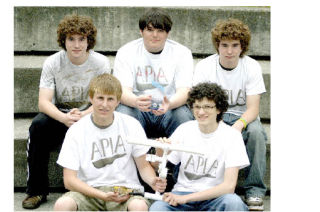LANGLEY — When smart kids put their heads together, they can do just about anything.
Need proof? Consider the five South Whidbey High School students who decided a year ago that they wanted to enter a remotely operated submersible vehicle — an ROV — in a contest sponsored by a Northwest technology organization.
“We saw an article about the contest in a newspaper and decided to start our own group,” Kip Hacking said.
Hacking and Kimmer Webb, Geoff Wilson, Aren Mattens and Evan Mattens formed A.P.I.A., an acronym denoting the Atlantic, Pacific, Indian and Arctic seas.
Guided by their parents and a burning need to overcome the challenges they faced, the team designed and built a submersible vehicle with two forward- and backward-mounted propellers, a vertical-mounted propeller, a “grabber claw,” a thermometer and a camera.
“There were a lot of brain-storming sessions over the months as we tried to figure out the mechanics of the thing,” Wilson said.
Evan Mattens explained the group went on-line and built a small prototype device. They got significant help from Wilson’s father Eric, who had designed small submarines in college.
Wilson helped teach the team about DC motors, propeller design, trim and stability and other areas of marine technology.
As always, funding to buy needed parts was a problem. But the five students had a car wash and garage sale to raise money. The whole project ended up costing about $450.
The hardest part was to get the claw to work, a key component since picking objects up underwater was a primary goal.
Their winning contraption took shape from PVC piping, soldered brass propellers — brass doesn’t rust in water — fans created from Kerr canning lids and controllers from a Ford van. The team made design modifications up to the last moment.
On May 10, they took their device to a competition of 13 high school teams held at the Weyerhaeuser King County Aquatic Center in Federal Way.
Student teams from middle schools, high schools, home schools and community colleges and universities participated in the event, which consisted of different classes that varied depending on the sophistication of the ROV built and the mission requirements.
The boy’s objective involved retrieving rocks attached to the vertical column of a simulated smoker vent on the ocean floor, which was located 17 feet below the surface of the diving pool. The machine also had to grab simulated crabs from the ocean floor and take the temperature of the vent.
As 30 professional marine scientists watched, the team had five minutes to set up, 15 minutes to conduct the tests and five minutes for take-down.
Things didn’t go completely according to plan. Twice their tether snapped and had to be repaired on the spot.
Evan Mattens was the “pilot,” gently guiding the ROV through its paces. A curtain prevented him from seeing anything so he had to track the device with a miniature camera.
“I couldn’t see a thing,” he recalled.
The team took second place in the competition, won “best display” and was awarded
$500 and a trophy.
All the boys are geared up to compete next year now that their learning curve is a bit shallower.
“I learned a lot about soldering and engineering an ROV from scratch,” Aren Mattens said.
Wilson found that just because something doesn’t work the first time, the process of fixing can be a learning experience.
And Webb discovered something else, as important to him as winning a trophy.
“Communication between team members is vital,” he said. “Working together toward a shared goal has its own rewards.”



